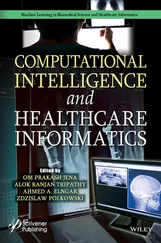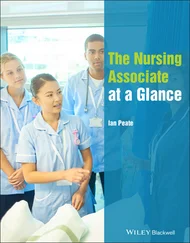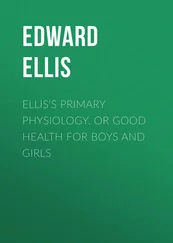Identifiers: LCCN 2022007589 (print) | LCCN 2022007590 (ebook) | ISBN 9781119757207 (paperback) | ISBN 9781119757214 (adobe pdf) | ISBN 9781119757221 (epub)
Subjects: MESH: Anatomy | Physiological Phenomena | Handbook | Nurses Instruction
Classification: LCC QP40 (print) | LCC QP40 (ebook) | NLM QS 39 | DDC 612.0076–dc23/eng/20220222
LC record available at https://lccn.loc.gov/2022007589
LC ebook record available at https://lccn.loc.gov/2022007590
Cover Design: Wiley
Cover Images: © SEBASTIAN KAULITZKI/Getty Images, PIXOLOGICSTUDIO/Getty Images
Iam delighted to have been asked to provide a second edition of Anatomy and Physiology for Nursing and Healthcare Students at a Glance . This popular revision aid has retained the user‐friendly approach that includes bite‐sized pieces of information and full‐colour diagrams that help students retain, recall and apply facts to their practice.
All health and care providers aim to offer care that is safe and effective. In order to care effectively for people (sick or well), it is essential to have an understanding of and insight into anatomy and physiology.
The human body is composed of organic and inorganic molecules organised at a variety of structural levels; despite this, an individual should be seen and treated in a holistic manner. If the healthcare professional is to provide appropriate and timely care, it is essential that they are able to recognise illness, take prompt action to deliver effective treatment and refer appropriately, ensuring that the person they offer care and support to is at the centre of all that they do.
Healthcare professionals are required to demonstrate a sound knowledge of anatomy and physiology with the intention of providing safe and effective nursing care. This is often assessed as a part of a programme of study using a number of assessment techniques. The overall aim of this concise text is to provide an overview of anatomy and physiology and the related biological sciences that can help to develop your practical skills and improve your knowledge with the aim of you becoming a caring, knowledgeable and compassionate provider of care. It is anticipated that you will be able to deliver increasingly complex care for the people you care for when you understand how the body functions.
As you begin to appreciate how people respond or adapt to pathophysiological changes and stressors, you will be able to understand that people (regardless of their age) all have unique biological needs. The integration and application of evidence‐based theory to practice is a key component of effective and safe healthcare. However, this goal cannot be achieved without an understanding of anatomy and physiology.
An additional chapter has been introduced, Anatomical Terms, emphasising the importance of understanding and using the correct anatomical terminology when making a description of body parts as a shared method of communicating between health and care staff. This new edition also includes clinical practice points which aim to encourage readers to relate the theoretical concepts described to practice.
Anatomy is associated with the function of a living organism and as such it is almost always inseparable from physiology. Physiology is the science dealing with the study of the function of cells, tissues, organs and organisms; it is the study of life.
Ian Peate London
ACTH Adrenocorticotrophic hormoneADH Antidiuretic hormoneANPAtrial natriuretic peptideANSAutonomic nervous systemATPAdenosine triphosphateAVAtrioventricularBBBBlood–brain barrierBPBlood pressureCa 2+CalciumCCKCholecystokininClChlorideCNSCentral nervous systemCRHCorticotrophin‐releasing hormoneCSFCerebrospinal fluidCO 2Carbon dioxideCRCCardioregulatory centreCSFCerebrospinal fluidDNADeoxyribonucleic acidEPOErythropoietinFSHFollicle‐stimulating hormoneGHGrowth hormoneGHRIFGrowth hormone release‐inhibiting factorH +HydrogenH 2OWaterHbHaemoglobinHCGHuman chorionic gonadotrophinHCLHydrochloric acidHRHeart rateK +PotassiumkPaKilopascalMg 2+MagnesiummmHgMillimetres of mercurymRNAMessenger ribonucleic acidNa +SodiumNH 3AmmoniaO 2OxygenPCAPosterior cerebral arteryPCO 2Partial pressure of carbon dioxidePCTProximal convoluted tubulepHA measure of the acidity or basicity of an aqueous solutionPNSParasympathetic nervous systemPO 2Partial pressure of oxygenPRHProlactin‐releasing hormoneRBCRed blood cellRERRough endoplasmic reticulumRNARibonucleic acidrRNARibosomal ribonucleic acidSASinoatrialSERSmooth endoplasmic reticulumSNSSympathetic nervous systemtRNATransfer ribonucleic acidTSHThyroid‐stimulating hormoneWBCWhite blood cell
Ian would like to thank his partner Jussi Lahtinen and also Mrs Frances Cohen for all their support and encouragement.
How to use your revision guide and the companion website
Features contained within your revision guide
Each topicis presented in a double‐page spread with clear, easy‐to‐follow diagrams supported by succinct explanatory text.



Figure 1.1 The standard anatomical position.

Figure 1.2 Anatomical terms.
Source: Tortora GJ, Derrickson B. (2017) Tortora’s Principles of Anatomy and Physiology, 15th edn. Hoboken: Wiley
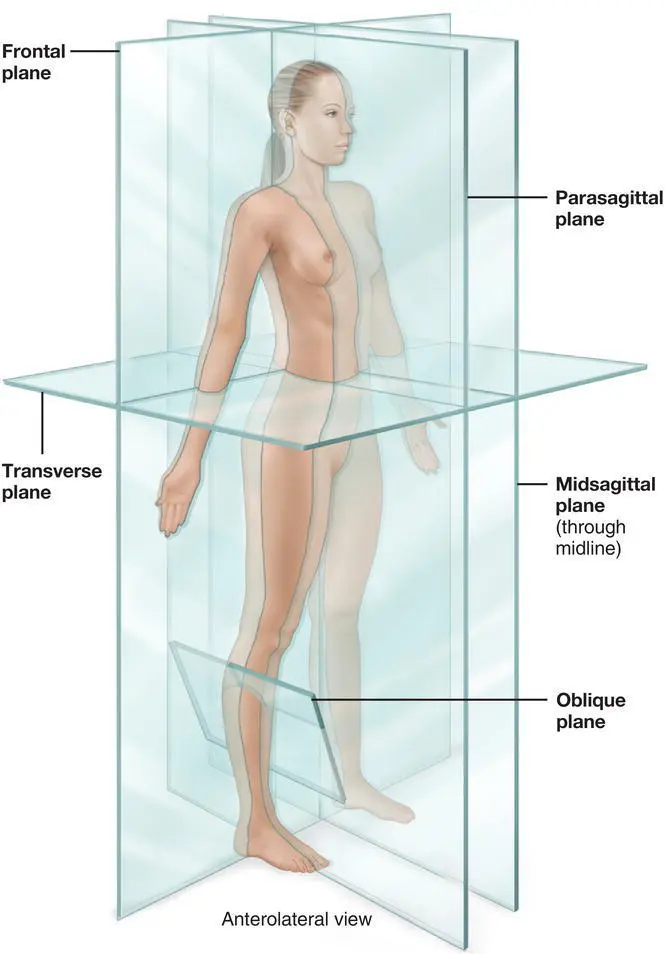
Figure 1.3 Anatomical planes.
Source: Tortora GJ, Derrickson B. (2017) Tortora’s Principles of Anatomy and Physiology, 15th edn. Hoboken: Wiley
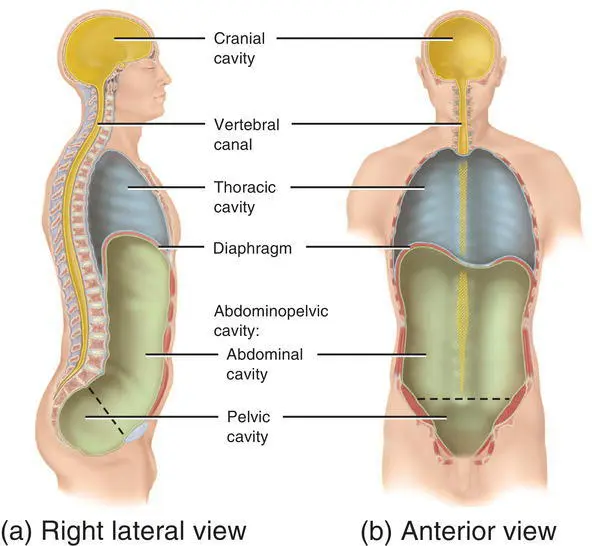
Figure 1.4 Body cavities.
Source: Tortora GJ, Derrickson B. (2017) Tortora’s Principles of Anatomy and Physiology, 15th edn. Hoboken: Wiley, with permission from John Wiley & Sons.
Table 1.1 The body cavities.
| Cavity |
Content |
| Dorsal |
Cranial cavity: holds the brain Spinal cavity: includes spinal column and spinal cord |
| Ventral |
Thoracic cavity: surrounded by the ribs and chest muscles, superior to the diaphragm and abdominopelvic cavity. Further divided into the pleural cavities (left and right) which contain the lungs, bronchi and the mediastinum which contains the heart, pericardial membranes, large vessels of the heart, trachea, upper oesophagus, thymus, lymph nodes and other blood vessels and nerves Abdominopelvic cavity: divided into the abdominal cavity and pelvic cavity. The abdominal cavity: is between the diaphragm and the pelvis, lined with a membrane, contains the stomach, lower part of the oesophagus, small and large intestines (apart from sigmoid and rectum), spleen, liver, gallbladder, pancreas and adrenal glands, kidneys and ureters. The pelvic cavity: contains the urinary bladder, some reproductive organs and the rectum |
Читать дальше











